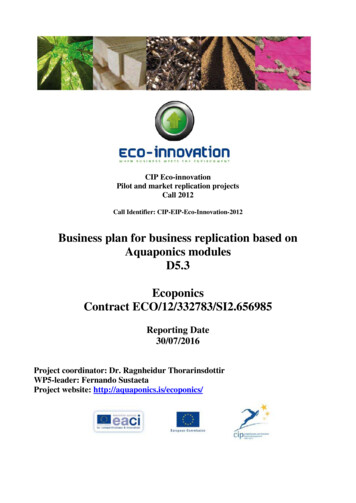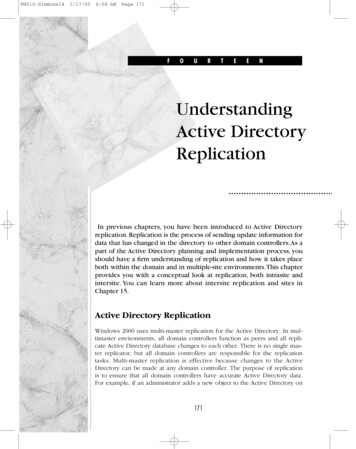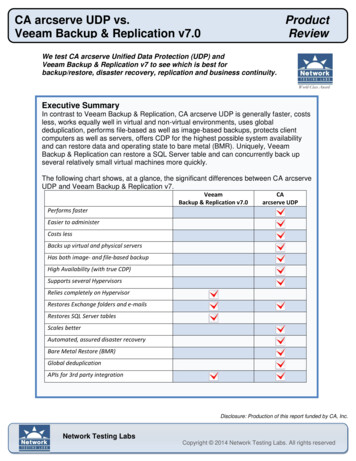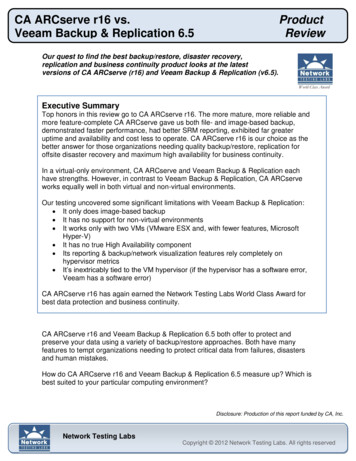
Transcription
CIP Eco-innovationPilot and market replication projectsCall 2012Call Identifier: CIP-EIP-Eco-Innovation-2012Business plan for business replication based onAquaponics modulesD5.3EcoponicsContract ECO/12/332783/SI2.656985Reporting Date30/07/2016Project coordinator: Dr. Ragnheidur ThorarinsdottirWP5-leader: Fernando SustaetaProject website: http://aquaponics.is/ecoponics/
CIP-EIP-Eco-Innovation-2012: Pilot and market replication projects - ID: ECO/12/332783/SI2.656985 ECOPONICSLarge Scale Aquaponic Production Business PlanECOPONICSDeliverable D5.3p. 2 of 64
CIP-EIP-Eco-Innovation-2012: Pilot and market replication projects - ID: ECO/12/332783/SI2.656985 ECOPONICSINDEX1. - Introduction11.1. - Background11.2. - Suitability of Tilapia12. - Methodology22.1. - Systematic22.2. - Overview32.3. - Habitat42.4. - Food in natural conditions42.5. - Fertilization and playback43. - Tilapia farming53.1. - Global importance of cultivating Tilapia53.2. - Legal and administrative framework63.3. - Possible interactions with other interests73.4. - Tilapia farming in Spain73.4.1. - Existing holdings73.4.2. - Potential83.5. - Marketplace93.6. - Production113.7. - Processing Plants133.8. - Product Quality143.9. - Marketable by-products153.10. - Marketing and distribution154. - Market strategies and public acceptance164.1. - Product Presentation184.2. - Types of submission of the Tilapia184.3. - Technical difficulties and risks184.4. - Continuous Improvement Plan195. - BREEN culture methodology5.1. - Thermal management of water5.1.1. - History temperatures during the pilot test BREEN2021245.1.2. - Effect of temperature on the temperature of cultivationtanksDeliverable D5.325p. 3 of 64
CIP-EIP-Eco-Innovation-2012: Pilot and market replication projects - ID: ECO/12/332783/SI2.656985 ECOPONICS5.2. - Intensive farming of tilapia in recirculation285.3. - Food305.4. - Food safety and traceability315.5. - Traceability325.6. - Automated Feed335.7. - Growth345.8. - Pathologies345.9. - Treatment355.10. - Environmental Hazard crop365.11. - Geographic Limitations for growing Tilapia with a BREENsustainable system395.12. - Aquaponics396. - Production at industrial levels426.1. - Calculation of production and facilities426.2. - BREEN Industrialization Project for a Company of the fisheries sector446.2.1. - Aquaculture Production, Tilapia culture446.2.2. - Advantages and disadvantages of a BREEN system in thefacilities of a Company of the fisheries sector6.2.3. - Material farming tanks486.2.4. - Greenhouses for growing aquaponic516.2.4.1. - Characteristics of greenhouse6.3.- Costs51566.3.1. - Direct staff costs566.3.2. - Subcontracting566.3.3. - Travel costs and subsistence allowances for staff566.3.4. - Costs of equipment and infraestructure576.3.5. - Aquaculture production costs and plant576.4. - IncomeDeliverable D5.34659p. 4 of 64
CIP-EIP-Eco-Innovation-2012: Pilot and market replication projects - ID: ECO/12/332783/SI2.656985 ECOPONICS1. - Introduction1.1. - BackgroundThis project has been created by the technical team BREEN SL. This project aims to promote cropdiversification and the sustainable production of fish in the Spain while meeting the objectives setby the Master Plan for Aquaculture ACBC 2009-2013.For this we have chosen a kind species of fish of global importance which is still largelyunknown to producers and markets in Spain and even Europe, the Tilapia (Orechromis niloticus).This project aims to create sustainable production of Tilapia focused on three main areas:- Sustainability in water management, recycling and Aquaponics- Energy sustainability, renewable energy and energy efficiency- Sustainability in the food for the production of Tilapia, without dependence on marine resourcesor the environment.1.2. - Suitability of TilapiaThere are different species known generically as Tilapia which is one of the biggest fish groups inglobal aquaculture. Where it is produced, it has resulted both to be a profitable and competitiveproduct that is a good alternative protein with excellent prospects for development.White meat, solid and neutral in flavor, it is a product that makes its way easily in differentworld markets to the point of becoming the second most popular farmed fish after carp andsurpassing salmon.Besides its quality, its success is due to its ease of cultivation. It is an easily adaptablespecies to intensive cropping systems and has a high rate of reproduction, high disease resistance,high survivability, etc. and able to grow well in a wide range of physico-chemical qualities of water.Deliverable D5.3p. 5 of 64
CIP-EIP-Eco-Innovation-2012: Pilot and market replication projects - ID: ECO/12/332783/SI2.656985 ECOPONICS2. - MethodologyTo achieve the objectives outlined, this project follows the guidelines set out below:- Characterization of the environmental requirements of tilapia from knowledge of its biology- Delimitation of biomarkers that meet the requirements of this technology as suitable for tilapia.- Identifying sustainable growing environmental risks and other limiting factors.- Review and analysis techniques and sustainable farming technologies most suitable for thespecies in the environmental conditions for its production- Crop adaptation to environmental risk prevention.- Marketability, distribution etc., and an analysis of the economic viability of the facility.- Production volumes- Calculate investment costing- Production costingThe whole process is performed by collecting documentation, consultations with specialists in thespecies, looking at different national and international facilities and the experience gained throughthe production of the pilot BREEN.2.1. - SystematicUnder the common name of Tilapia are grouped more than 100 different species, all belonging tothe family of cichlids that inhabit both freshwater and brackish in Africa and the Middle East. Forits adaptability, meat quality and rapid growth, many of the species that are grouped under thecommon name of Tilapia they are among the most cultivated species in fish farms on fivecontinents.For Zootechnical commercial purposes they are often not differentiated between differentspecies of Tilapia.Taxonomy:- Phylum: Cordata- Class: Actinopterygii- Order: Peciforme- Family: Cichlidae- Subfamily: PseudocrenilabrinaeDeliverable D5.3p. 6 of 64
CIP-EIP-Eco-Innovation-2012: Pilot and market replication projects - ID: ECO/12/332783/SI2.656985 ECOPONICS- Gender: Oreochromis- Species: NiloticusOrechromis Tilapia niloticus, and Nile tilapia, are herbivorous or omnivorous fish verysuitable for cultivation because of the high yields that can be obtained from them, in fact, by far themost widely cultivated species of Tilapia in whole world.The chromaticity is an aspect that contributes significantly to the differentiation of thedifferent species.Treatment species O. mossambicus x O. niloticus x O. aureus, has led to the development ofa hybrid of great importance for aquaculture called red Tilapia.Pure Tilapia species are more favorable for growing, however, as has happened in othercountries, the activity is geared to growing the red tilapia hybrid form or, as the mostenvironmentally sensitive, offers many more guarantees from the point of view of reproductivesuccess in the wild in the Basque Country and Spain in the event of leakage or uncontrolledreleases.The introduction in recent years of genetic selection techniques has made obtaining purelines of the same sex (males supermachos or YY), which have eliminated the problem of theviability of the specimens in case of accidental escape.2.2. - OverviewThe origin of the Nile Tilapia is in Africa, occupying the basins of major rivers the African varietyhas seven distinct subspecies. Subsequently it has spread throughout the world, especially intemperate and tropical America and Asia. It is also grown in industrial, hot water in some parts ofEurope.Nile tilapia has a spindle shape and is of medium size, and is equipped with a midline,following the characteristic pattern of cichlids.Structurally, the body of Tilapia is laterally compressed, so that it has a blowhole on eachside, with scales and appears in some cases cycloid ctenoid. Another distinctive anatomical featureis the presence of numerous spines along the dorsal and anal fin. The operculum is thorny.There is a significant size difference in growth between males and females.Deliverable D5.3p. 7 of 64
CIP-EIP-Eco-Innovation-2012: Pilot and market replication projects - ID: ECO/12/332783/SI2.656985 ECOPONICS2.3. - HabitatTilapia are euryhaline, ie support a wide range of salt content in the water, being able to live in freshand brackish envirnoments, although do not tolerate sudden changes in salinity. Tilapia, as a resultof these features have colonized diverse habitats such as streams, rivers, lakes, lagoons, brackishand salt etc. In all cases the preference of Tilapias are slow-flowing waters, remaining in shallowareas near the shore where they develop throughout their life cycle.The natural range of temperature ranges between 20-30 C, 24-29 C which represent thebeing optimum for reproduction. Although it can withstand lower temperatures, the mere fact thatdeclines occur and cause fluctuations in the metabolic dysfunctions that result in increasedvulnerability to disease, reduced reproductive success and slowdown growth. Temperatures below15 C cause death in the short term and below 10 º C immediate death.2.4. - Food in natural conditionsTilapia have herbivorous or omnivorous eating habits. Small aquatic insects, phytoplankton, detritusof different origins and even bacteria comprise their diet. In times of food shortage they can eattheir own feces.As larvae Tilapia sustinance is guaranteed by the nutrients in their yolk sac in their first daysof life, which they depend on for an average of 5 days. When the larva has reabsorbed 60-75% oftheir lipid reserves it is when they begin to forage independently.Their main food during this first phase in which its digestive system is still not fullydeveloped, are micro algae. These micro algae provide proteins and amino acids necessary forproper development.2.5. - Fertilization and playbackIn the wild, the reproductive phase is carried out when the temperature range is optimalThe male clears an area to make a nest or defends an area for spawning. Later it attracts receptivefemales by performing courtship displays.The female then proceeds to lay eggs which are immediately fertilized by the male, afterwhich the female keeps them in her mouth for incubationThe eggs remain within the female's mouth for a period of between 5 and 10 days dependingon the water temperature, while developing.Deliverable D5.3p. 8 of 64
CIP-EIP-Eco-Innovation-2012: Pilot and market replication projects - ID: ECO/12/332783/SI2.656985 ECOPONICSOnce hatched, the eggs inside the female's mouth, the fry begin to swim from the mouth ofthe mother to fee, but returning again at the slightest sign of danger.Once the size of the fry starts to hinder their stay inside the mother's mouth, they begin tobecome independent, they move toward warm water and shallow protected enclaves.The female will be able to make another start in less than four weeks from the release of thefry.In the wild, the fry mature between 10-12 months, when they reach a weight of about 500600 grams. Under optimal growth conditions, tilapia can reach sexual maturity at 4-5 monthsweighing between 150-200 grams.3. - Tilapia farming3.1. - Global importance of cultivating TilapiaTilapia offers competitiveness as hatchery species, because of its high quality, pleasant taste andwide tolerance to different environmental conditions, added resistance to common diseases offarmed fish, their relative ease of reproduction and growth rate in intensive farming.All these qualities are of high interest for aquaculture, and have led Tilapia to occupy the secondmost important group of species in world of aquaculture production, after the tents, with a volumeof approximately 20% of total farmed fish production and are in a process of continuous growth.According to the FAO global production of 3.2 million tons in 2010, China was the largestproducer contributing about 40% of total world production, followed by Egypt, Indonesia etc.Image 1: World's biggest Tilapia producersDeliverable D5.3p. 9 of 64
CIP-EIP-Eco-Innovation-2012: Pilot and market replication projects - ID: ECO/12/332783/SI2.656985 ECOPONICSFor some years, Tilapia has been the third most imported aquatic food product by the U.S. aftershrimp and Atlantic salmon, and has been awarded as the Fish of the Year for 6 consecutive years.In 2010 total consumption of Tilapia was approximately 466,000 tons with exciting growthprospects in the coming years, it will be placed in the top ten products of aquaculture and fisheriessector. Consumption is expected to maintain at a minimum average annual increase of 3%.Globally, the increase of tilapia production shows strong growth, giving the product aleading role as a first-order food for the future, especially in developing countries, high populationareas etc., It is of particular interest as a viable alternative to capture fisheries at a time when fishstocks are overexploited and social sensitivity demands support of sustainable production andenvironmental quality over time.At the European level, there is hardly any production of Tilapia but instead it is importedfrom China amounting to about 20,000 tons annually, it is imported frozen whole and filleted andthe countries shown in the table below are the biggest consumers in Europe.3.2. - Legal and administrative frameworkTo install a fish farm in Spain it must comply with the requirements of the AutonomousCommunity, the Hydrographic Confederation, the city etc.Within these requirements and in the case of an alien species, all autonomous communitiesall require a process of environmental impact assessment or at least an environmental report,
6.2.4.1. -Characteristics of greenhouse 51 6.3.-Costs 56 6.3.1. -Direct staff costs 56 6.3.2. -Subcontracting 56 6.3.3. -Travel costs and subsistence allowances for staff 56 6.3.4. -Costs of equipment and infraestructure 57 6.3.5. -Aquaculture production costs and plant 57 6.4. -Income 59











